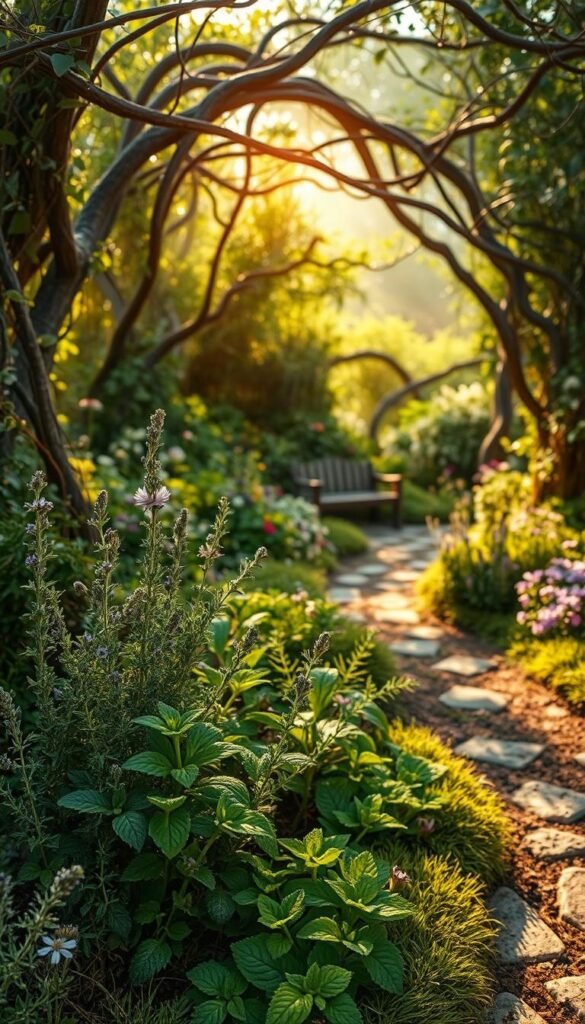Imagine stepping into a tiny realm where practical greenery meets enchanting design. These miniature landscapes let you craft a living storybook scene right in your backyard or windowsill. By blending fragrant plants with whimsical decor, you create spaces that delight the senses while serving everyday needs.
Folklore suggests certain aromatic varieties attract mystical visitors. Thyme whispers secrets of courage, rosemary carries memories, and lavender weaves calming spells. These plants do more than charm winged guests – they become kitchen staples and natural remedies for your home.
You don’t need sprawling acreage to start. A simple container transforms into an entire universe with dwarf shrubs, pebble pathways, and maybe a tiny door nestled among leaves. Children will marvel at hidden details, while adults appreciate the dual-purpose beauty of greenery that’s both decorative and useful.
This creative approach connects modern gardeners with age-old traditions. Early European cottagers grew medicinal herbs near miniature “fairy stones,” believing good spirits protected their crops. Today’s versions keep that magical spirit alive while fitting contemporary lifestyles through space-saving designs.
Whether you’re crafting a tabletop wonder or revamping a garden corner, these living dioramas become conversation starters. They invite imagination to bloom alongside basil and mint, proving functionality and fantasy make perfect partners.
Enchanting Beginnings: The Magic of Fairy Gardens
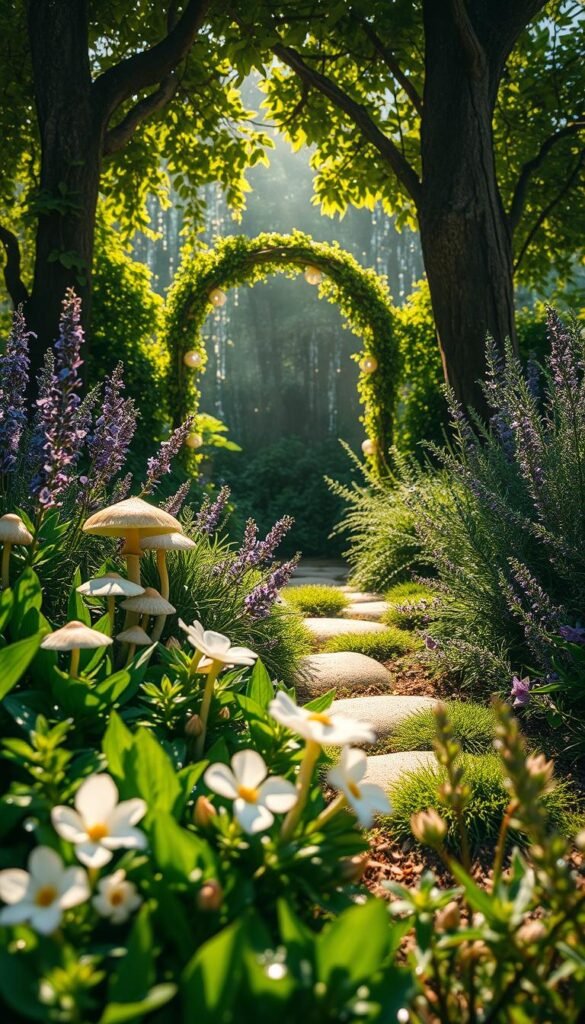
Tiny worlds spark big wonder when you craft a living canvas that fits in your palm. These miniature escapes blend storytelling with nature, letting you design a realm where every pebble tells a story and each leaf hides secrets. Unlike traditional plots, these spaces thrive on whimsy and scale, inviting you to kneel closer and discover hidden treasures.
What Makes These Mini Worlds So Special?
Their power lies in transformation. A teacup becomes a pond. A seashell turns into a bench. This scale shift makes ordinary items extraordinary, encouraging creative problem-solving. Children adore the playfulness, while adults rediscover childhood wonder through tiny bridges and wee cottages.
These gardens act as portals between daily life and fantasy. When you arrange mossy hills or position a miniature swing, you’re not just gardening—you’re world-building. Studies show engaging with small-scale nature reduces stress, making these creations both joyful and therapeutic.
Herbs: Nature’s Fairy Allies
Fragrant greens elevate your design from cute to captivating. Rosemary’s spiky silhouette mimics fairy forests, while creeping thyme forms velvety carpets. Their scents awaken memories and attract butterflies, creating movement in your tiny paradise.
Many cultures associate herbs with mystical properties. Lavender wards off negativity. Basil symbolizes protection. By including these plants, you honor ancient traditions while adding practical benefits. Snip leaves for cooking or dry petals for potpourri—your enchanted space serves multiple purposes.
Magical History and Folklore of Fairy Gardens
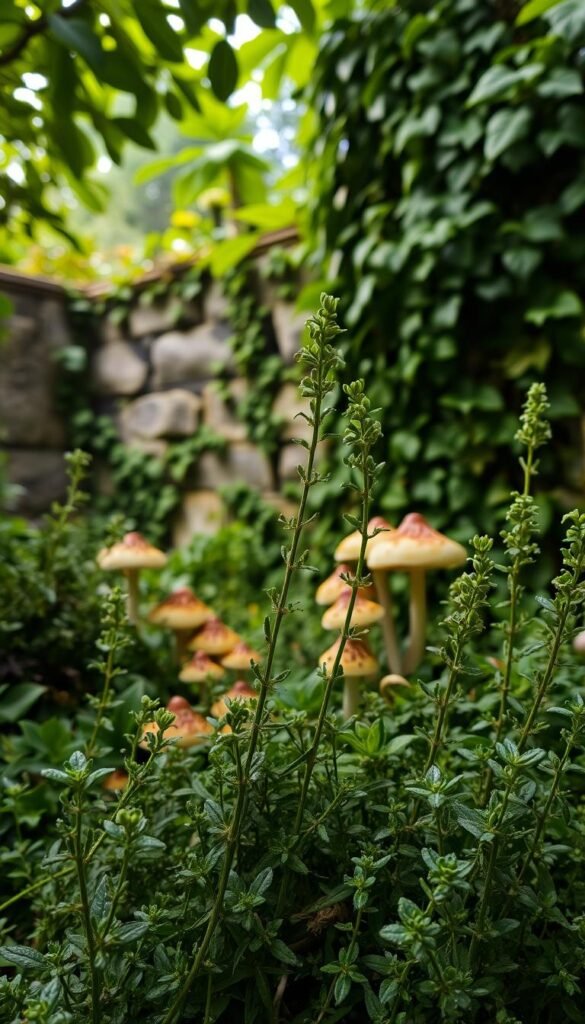
Long before miniature cottages dotted tiny landscapes, ancient cultures wove stories about nature’s hidden guardians. These tales reveal why certain plants became sacred bridges between humans and mystical beings.
Legendary Roots and Timeless Tales
Celtic farmers once left offerings near hawthorn trees, believing fairies protected their crops. Norse myths spoke of landvættir—spirits dwelling in rocks and herbs. This global thread connects Hawaiian legends of menehune builders to Cherokee stories of Yunwi Tsunsdi, the “Little People.”
“I know a bank where the wild thyme blows, Where oxlips and the nodding violet grows.”
Inspiration from Shakespeare and Traditional Myths
The Bard’s play immortalized thyme as Titania’s resting place, linking literature to garden design. Foxgloves earned names like “fairy caps” because folklore claims these blooms house sleeping sprites. Medieval healers often planted yarrow and St. John’s wort, trusting their magic to strengthen remedies.
| Culture | Sacred Plant | Belief |
|---|---|---|
| Celtic | Hawthorn | Gateway to Otherworld |
| Germanic | Mugwort | Protection from spirits |
| Cherokee | Corn | Yunwi Tsunsdi’s gift |
| Medieval | Rosemary | Memory preservation |
Your garden becomes part of this living history when you include plants like thyme or foxglove. These choices honor centuries of storytelling while creating spaces where imagination thrives alongside greenery.
Planting Herbs in a Fairy Garden for a Fragrant, Functional Twist
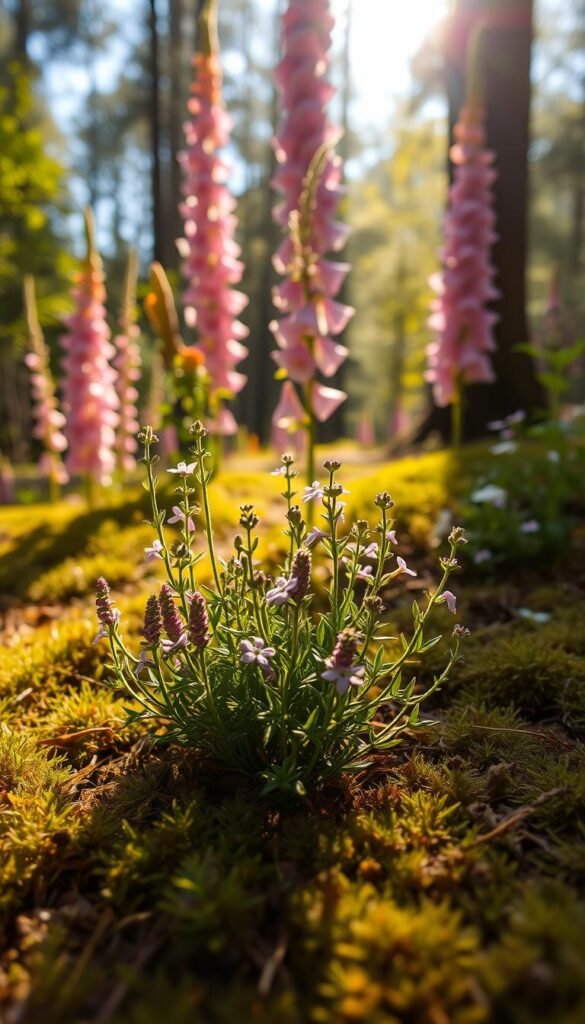
Crafting an aromatic haven starts with selecting greenery that bridges myth and practicality. The right choices transform your space into a living story where botany meets bedtime tales, offering sensory delights and kitchen-ready ingredients.
Essential Herbal Choices for Your Garden
Thyme varieties reign supreme in these miniature realms. Creeping types form emerald carpets perfect for tiny pathways, while lemon-scented versions release citrusy notes when brushed. Shakespeare immortalized wild thyme as Titania’s bedchamber, making it a must-have for literary magic.
Foxgloves tower like fairy skyscrapers with bell-shaped blooms. These vertical showstoppers create hiding spots for imagined sprites while attracting hummingbirds. Pair them with saffron crocuses – their golden threads flavor dishes and dye fabrics, just as folklore suggests fairies prefer.
Why Thyme and Foxgloves Hold a Special Place
Beyond their visual charm, these plants serve practical roles. Thyme’s antimicrobial properties make it a natural first-aid herb, while foxglove leaves (though toxic) inspired modern heart medications. “The elves that creep about each budding flower,” wrote poet John Clare, capturing why these species feel inherently magical.
Consider growth patterns when designing. Low-growing herbs like woolly thyme create texture, while rosemary’s upright form mimics miniature trees. Perennial choices like sage ensure your creation thrives year after year, becoming a cherished part of your outdoor space.
Setting the Stage: Preparing Your Garden Space
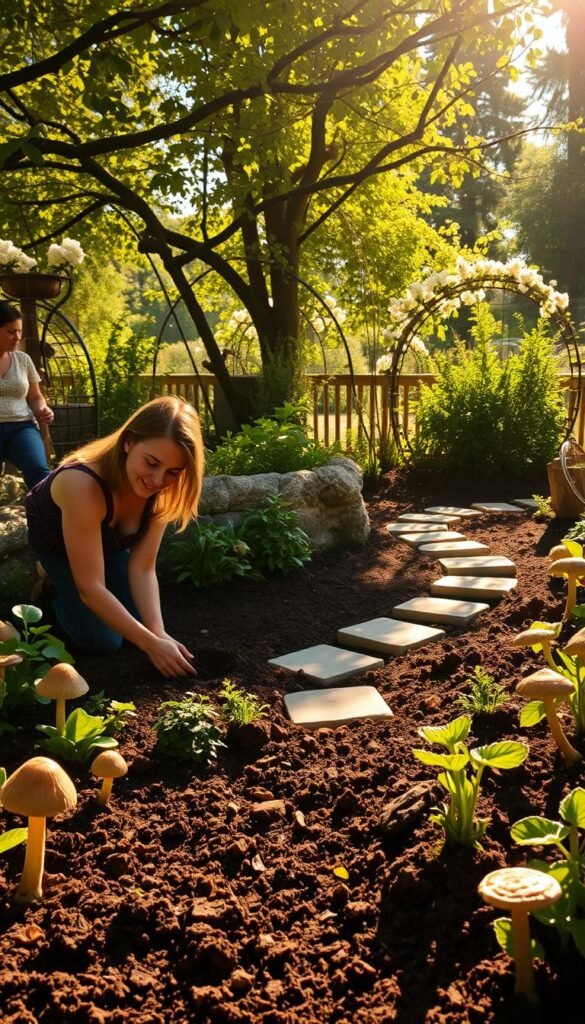
Creating your enchanted oasis begins with smart groundwork. The right foundation ensures your tiny paradise thrives while keeping its magical charm. Let’s explore how to set up a space where whimsy meets practicality.
Soil Preparation and Natural Amendments
Well-draining soil forms the backbone of any successful garden. Mix two parts potting soil with one part perlite for optimal drainage. This combo prevents soggy roots while letting herbs access nutrients.
Test your soil’s pH using a simple kit from any gardening store. Most aromatic plants prefer slightly alkaline conditions. If your soil leans acidic, add crushed eggshells or wood ash to balance it naturally.
| Soil Type | Amendment | Benefit |
|---|---|---|
| Clay | Coarse Sand | Improves drainage |
| Sandy | Compost | Boosts nutrients |
| Acidic | Lime | Raises pH level |
| Compact | Vermiculite | Aerates roots |
Choose locations with morning sun and afternoon shade. A spot under a tree or beside a bench works perfectly. For small-space gardening, use containers with drainage holes to control soil quality.
Plan your layout considering mature plant sizes. Leave enough room for thyme to creep and rosemary to reach its full height. Elevated beds or terrariums help manage tricky ground conditions while maintaining that storybook scale.
Techniques and Tips for Successful Herb Planting
Mastering herb placement ensures both beauty and vitality in your miniature landscape. Smart strategies help maintain soil structure while letting creativity flourish. Follow these methods to keep your tiny ecosystem thriving through seasons.
Planting Methods for Vibrant Growth
Start with deep-rooted plants like rosemary or sage. Their established systems anchor the garden without disturbing nearby soil later. Test layouts by arranging furniture and accessories first—this prevents replanting damage.
After positioning key elements, level the ground gently. Water freshly placed greenery using a can with a fine rose nozzle. Check moisture by pressing a finger into the top inch of soil—only hydrate when it feels dry.
Seasonal Considerations in Herb Gardening
Spring welcomes new thyme sprouts, while summer demands shade for delicate mint. In autumn, trim woody stems to encourage next year’s growth. Winter protection might mean moving containers indoors or using cloches.
Time your plantings with local frost dates. Cool-weather herbs like parsley thrive in early fall, while basil loves summer heat. This rhythm keeps your fairy garden lively year-round, blending magic with practicality.

